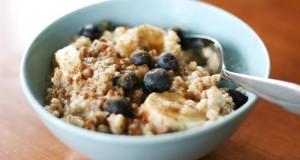 Stop! Step away from that cheeseburger and gigantic soda. Let’s take a moment and check out the menu. Healthy fast food options exist, but you’ve got to order carefully. Here’s how.
Stop! Step away from that cheeseburger and gigantic soda. Let’s take a moment and check out the menu. Healthy fast food options exist, but you’ve got to order carefully. Here’s how.
We’ve all been there. You’re on the road. You are in dire need of something quick and satisfying. No, I’m not talking about the gas-station attendant with the heart tattoo and the dreamy eyes – although quick and satisfying is probably just what she would be. I mean food: fast food.
Fast food has a lot going for it. It’s inexpensive, it’s convenient, it’s fast, and it can be tasty. But it’s also packed with sugar, salt, fat, carbs and calories.
Wouldn’t it be great if you could enjoy the speed and convenience of fast food without sacrificing your commitment to eating well? If there were actually healthy fast food options?
Good news: Fast food can be good for you now and then. Informed, healthy choices are possible, especially if you do a bit of preparation in advance.
Here are 10 ways you can eat well while eating fast.
#1 Look For Vegetarian Options
The beans at Taco Bell and some other fast food restaurants are vegetarian – just ask before you order. This is a fantastic option for anyone trying to cut meat-based saturated fats from their diets.
Vegetable-based dishes are not always vegetarian, however, so it’s important to ask. McDonald’s French fries, for example, list “natural beef flavor” as an ingredient, and in many locations they’re cooked in the same deep fryers as fish and chicken.
Poor-quality meat produced in inhumane “concentrated animal feeding operations” is on the menu at many fast foods joints. I avoid that meat whenever I can. The more I learn about the conditions there, the more reluctant I am to eat conventionally raised meat anywhere.
Even if you avoid meat, you’re still going to get plenty of salt, fat and sugar at any fast-food joint. But at least you might get a small serving of vegetables.
#2 Get the Facts
Lots of fast-food restaurants are responding to customer demand for healthier food and allergen-free options. If you find yourself on the road or stuck at an airport without a meal plan, chances are you’ll be able to find a salad, wrap, fruit bowl or vegetarian entrée that offers a semblance of health and nutrition. You can find gluten-free breading, rolls or pizza crust in many of the top chain restaurants today as well.
But don’t stop there! If you really want to make an informed decision when it comes to healthy fast food, you’re going to have to think about all of the ingredients. In some locations restaurants are legally required to post nutrition facts and calorie counts. In others, you can consult the Web. In either case, a bit of research can help you make better choices.
A quick glimpse at your smartphone will let you know exactly what you’re getting into when you place your order.
#3 Count Calories
Many seemingly healthy items are still packed with calories and unhealthy doses of salt, sugar and saturated fat. This helps to preserve the food and make it more appetizing.
The salad you order may seem healthful until you take the dressing and croutons into account. And what about the sugary yogurt dip that accompanies your fruit plate?
Menus are misleading. It’s not just the biggest item on the plate you have to think about. The condiments and dressings and side dishes can really add up. There’s no substitute for counting calories and tracking nutritional facts.
#4 Order Fruit Instead of Fries
Everybody loves fries, but you probably want to get the apple instead. In the long run, your body will thank you.
Fries can be baked at home and made in a much healthier (yet satisfying!) way with a lot less salt and fat. Experiment with different herbs and ground spices. You’ll find your whole family loves oven-roasted “fries” even more than the ones that come from the burger place.
An apple is an apple. Even if it’s been cut and sprayed with preservatives or pumped up with artificial grape flavoring for some insane reason, it still contains fiber and vitamins. It’s almost always a good choice.
The fries, on the other hand, could raise your blood pressure (since they’re coated with salt) and turn straight into glucose (which will flood your bloodstream almost as soon as you swallow).
Which is better for your body? It’s no contest.
#5 Avoid Carbonated Beverages
No matter what else you do, you’ve got to ditch the soda.
Scientists have discovered that our bodies don’t respond to calories in liquid form the same as we do when chewing is involved.
We can gulp down a lot of sugar water (that’s what soda really is — liquid candy) before we start feeling full, making it possible to consume a ton of non-nutritive calories.
Some fast-food restaurants are now offering milk or juice instead. Though juice boxes often marketed primarily to kids, you can enjoy them too.
#6 When in Doubt, Drink Water
Be careful to distinguish real juice, which contains vitamins and actual fruit, from fruit drink, which has tons of added sugar, artificial additives, and little to no nutritive value whatsoever. In general, that lemonade is probably sugar-packed and artificial. When in doubt, water is your best option. It’s hydrating, it’s not packed with unnecessary salt and sugar, and it might even be free.
#7 Look Beyond the Classics
When you find yourself in search of healthy fast food, learn to look beyond the classics. Places like McDonald’s and Burger King come to mind first when we think of fast food, and our minds run naturally to burgers and fries, but the truth is there are a lot of other options.
Many health-oriented small chains have sprung up in the past five years or so. These places can harder to find, but it’s worth a couple minutes of extra driving if you’re looking for a quick, satisfying and (at least somewhat) healthy meal.
For me, Mediterranean-style food and smoothies are the best options. They’re tasty, nutritive, and satisfying. Salads and sandwich-based items like falafel are quick to make, and many restaurateurs have been able to streamline the production process in the same way as a McDonald’s while using fresh, local ingredients. They avoid the added salt and sugar because they know many of their customers reject unhealthy indulgence in favor of a new kind of treat — the healthy fast food option.
#8 Split That Sandwich
Many restaurants serve outsized portions. It’s ridiculous that we are expected to eat whatever quantity of food is presented to us as a “single serving.”
The healthy option in this case is to listen to your body and stop eating when you’re full. Ask for dressing on the side, split the sandwich with your honey and stick to vegetarian options when in doubt.
#9 Speak Up!
When you discover that your favorite fast food establishment doesn’t offer menu items that work for you, or if you feel they could be doing more to provide healthy options for their customers, let them know. Leave comments online, talk to managers and spread the word via social media. Customers are the lifeblood of these businesses, and individual voices gathered to form a united chorus will eventually be heard. Even McDonald’s offers fruit juice, salads, and fresh fruit these days. It wasn’t their idea, believe me – they responded to pressure from customers.
#10 Slow Your Roll
Continue to make healthy food choices and let others know about them, too. The restaurants don’t make it easy. They’re loud and bright and confusing. If you’re like me, you’ve found yourself staring up at the menu board with no clue where to begin.
Take a minute to slow down. Ask questions. Order the meal that’s best for you.
If the line of customers behind you is too much pressure, check out the restaurant website and figure out what you’re going to order before you get there.
Fast food can still be an option. You just need to know how to identify healthy fast food options.
Source:youqueen.com
 Mithila.net Mithila.net, Easyrecipes, Way2Foodie, Way2Foodie.com, Non Veg Recipes, Veg Recipes, Veg Recipe, Veg Recipes, Andhra Recipes, South Spicy Recipes, Vantillu, Kitchen, Indian Recipes, Telugu Recipes,
Mithila.net Mithila.net, Easyrecipes, Way2Foodie, Way2Foodie.com, Non Veg Recipes, Veg Recipes, Veg Recipe, Veg Recipes, Andhra Recipes, South Spicy Recipes, Vantillu, Kitchen, Indian Recipes, Telugu Recipes,



